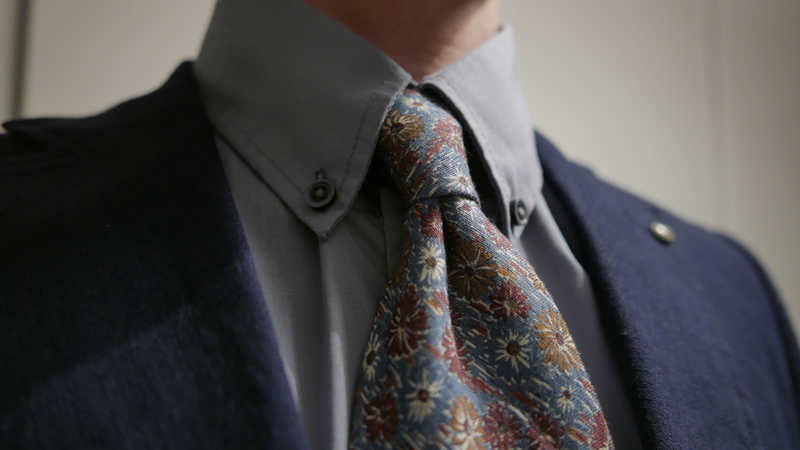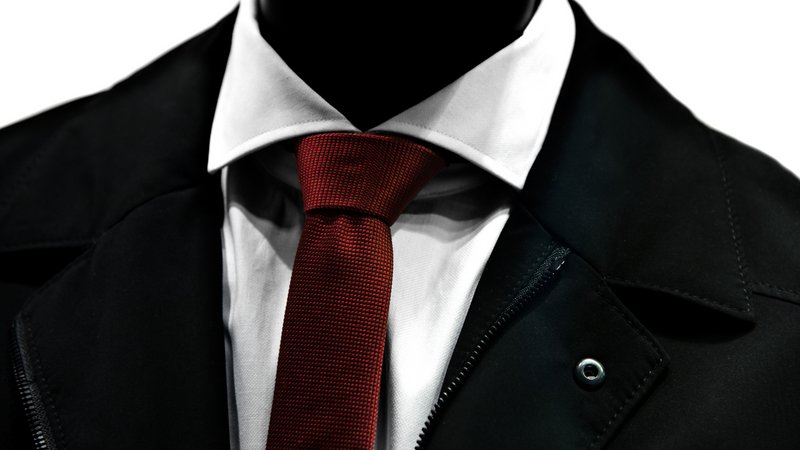Never underestimate a necktie. No matter where you look - movies, books or Wall Street, a good necktie makes quite an impression. And you need to be careful. It’s not just about choosing the right knot. The wrong colour, poor pairing or a lack of taste in the material of your necktie all affect your overall presentation. One size does not fit all. To ace your necktie game, you need to buckle up and read everything there is to know. For instance, necktie heights depend on body size. Yes, that’s a thing. But fear not. This guide will help you ace your necktie game like you just walked into an episode of Suits.
Ultimate guide: How to wear a necktie
The evolution of the necktie
Traditionally, the necktie was an essential piece of clothing. It was introduced in the 17th century as an ornament to honour soldiers of the war. Over time, this men’s suit accessory known as the cravat became a symbol of high fashion and status in Paris. Since then, until the end of the 20th century, it has upheld its position in society. A man without a necktie would be considered to have no taste and would not get as much respect. Even today, many organisations consider the tie as a formal part of their office dress code. We must add, it does add a sense of professionalism to a regular outfit. However, today’s Gen Z has turned to wearing men’s ties for fun. It has gone from a status symbol to a fashion accessory that can be paired with anything. However, it doesn’t always work and a well-done combination of suit and tie is still valued as much.
Wearing formal ties well shows that you mean business and you are ready to get things done. It’s a wonderful way to make an impact on your peers and seniors. The best way to ace your tie game is by understanding different types of men’s ties, how they work and which one you should pick for a particular situation. Once you get the basics right of how to wear a tie, there is no stopping you. Know how to wear a tie step-by-step, by learning about different types of suits for men and what ties go with them.
Types of ties
There are several different neckties classified depending on their purpose and design. Once you know which ties suit what event, 60% of your struggles are over.
The simple necktie

The most basic of them all, the necktie is a simple long piece of garment worn under a suit coat. Ties are often worn at the workplace and vary in fabric, patterns and colours. There are also several different ways to knot a formal tie. What colour or pattern you pick for a tie will set the mood for your outfit. Depending on whether you want to add a touch of casual or formal, are looking to create a festive look or just want to keep it minimal, a tie can help you achieve it.
The bow tie

The Bow Tie is a little stunner of a knot that goes around your neck. It’s an amazing way to make yourself look sharp. These are best worn at weddings, soirees and other casual outings. You can even pair a bow tie with a sleek tuxedo to stand out at a formal event. Know what the difference between a tux and a suit is to begin with.
If you had to have three solid ties in your cupboard, opt for a rich burgundy, a pastel sky blue and a light grey striped tie. Keep a crisp white shirt handy too. You can never go wrong with these.
Types of ties: Colours
Solid-coloured neckties

If you want to know how to wear a tie step-by-step, start with colours. A solid-coloured necktie is a minimal option. They don’t stand out and are the easiest to pull off, especially if you are still getting the hang of it. The only thing to remember is that matching ties with your outfit and your skin tone can make or break your look. Avoid black or white ties and pick a tie in a shade that matches your suit colours. It is the safest way to go about it. Apart from that, pick deep jewel shades for executive meetings and make them pop with lighter-coloured shirts; pastel shades are nice for office days and bolder shades for casual events.
Striped neckties

The diagonal-striped ties are a classic favourite. You can never go wrong with this one. They are versatile and easy to pair. Make it easier by pairing your suits in solid colours with stripes. Striped ties are not for formal business events. Solid ties make the most impact in these cases. Use lighter striped ties for office days and brighter shades for your casual outings.
Tartan, chequered or plaid ties

Chequered ties are fun but they can go wrong very easily. To play it safe, keep your suits in solid colours and try not to go crazy when matching colours. Don’t wear these for your formal business meeting and use complementing colours over contrasting ones for your office days. Look up the Glen Check - a tie that was popularised by the Prince of Wales - for some inspiration. These ties are easy to pair with for your casual days, but keep it simple.
Polka bot neckties

Polka dot ties have FUN written all over them. Keep it simple and stick to using these gorgeous ties for all your festive events and casual days. You can go crazy with colour pairings as long as there aren’t too many. Choose bigger dots for casual days and smaller dots for more formal occasions. If you plan on wearing a tie to the office, stick to dark ties with polka dots in lighter, neutral shades.
Apart from that, you also have Paisley Neckties, Geometric Neckties and Floral Neckties. Like the Polka Dot ties, they are better suited to casual occasions and must be paired carefully for office days.
Fabrics for ties
Tie patterns will determine your level of sophistication and what knot you choose to tie. Specific tie fabrics also work better on certain occasions. Keep reading to know more about what fabrics you can choose for your tie styles. This is crucial if you want to know how to wear a tie step-by-step.
Silk
Silk ties are the most common. Their elegant feel gives them a chic and premium look. They are also more elastic, so they don’t wrinkle very often. Silk ties come in prints and weaves and are perfect for all events and seasons.
Polyester
Polyester is a budget-friendly alternative to silk ties. It is light, easy to clean and does not wrinkle easily. However, they are not as porous as silk ties, making your neck feel sweaty and warm. Wear polyester tie styles during winter and don’t use them if you are someone prone to sweating.
Woollen
Woollen ties are thick ties made of the same fabric as your suits. They look sophisticated and are best worn with tweed suits. They are perfect for the winter season and recommended for casual outfits.
Linen
Designed from the fibres of a flax plant, linen is a light and breathable material. It was designed for hot summers. Linen ties are strong, and long-lasting, but can crease easily. To avoid creasing, pick ties with proper lining. Pair linen ties with woollen suits and keep them for your chic summer casual wear.
Cotton
Cotton ties were made for casual occasions. No one with even a beginner’s fashion sense would wear them anywhere else. Although they are similar to linen ties, they are wrinkle-free and don’t fade very easily. Keep these for your summer outfits too and pair them up with sleek linen suits.
If you had to have 3 different types of ties in your cupboard, pick silk, linen and woollen ties.
Tie knots
There are thousands of tie knots out there, enough to knot your brain trying to memorise it. However, this guide has picked out the 2 best knots that will help you make a good impression.
Four-in-hand

This is a basic knot that is commonly used everywhere. It is easy and a preferred choice to keep it simple but classy. You can choose this for your everyday office look and casual occasions. This knot gives a relaxed impression, so pick your situation accordingly. It is not recommended for interviews, formal business meetings and parties. It could give off the impression that you do not like making an effort. However, for fun social gatherings, it could look great around a loosened unbuttoned collar. You can use any tie fabric for this knot.
Full Windsor

The full Windsor knot is what makes an impression. It shows that you mean business and has a self-assuring, powerful vibe around it. Wear it at important business meetings and interviews, You can even swap it up with a half-Windsor knot to keep it a little more on the casual end.
How to wear a tie
Width and length
The secret to pulling off a good suit and tie is understanding proportions. Once you have a suit cut out for you, match your tie to its proportions. A wider body frame needs a wider tie and the same goes for narrower frames. This means that to accommodate the width of your tie, you need to work on the shirt’s collar too. Take a hint from your lapels to figure out what the width of your tie should be. Ideally, it varies between 2 to 3 inches. When it comes to the length of your tie, keep it in sync with the length of your trousers. A tie should be just long enough to touch your trouser’s waistband. Don’t let it go beyond your waistband or end just a little too high above it. Keep in mind these rules only apply when you have a custom-made suit. Pre-made suits won’t be designed in proportion to your body’s measurements.
How long should my formal tie be?
Your tie length should be in proportion to your body’s and suit’s dimensions. Ideally, a long necktie should touch the upper end of your waistband but not fall over it. Make sure you use a custom-made suit to gauge your tie length.
How wide should my tie be?
Your tie can be anywhere between 2 to 3 inches wide depending on your body frame. Compare it to your suit and match it to your lapels to get a perfect size.
What’s the best way to tie a tie?
The best way for wearing a tie is using the half Windsor knot. It isn’t too casual or too formal and perfect for most settings. The half Windsor knot works best with semi-formal events such as everyday office meetings, date nights and soirees.
What is the rule for wearing a tie?
Your tie needs to complement your suit and shirt’s colour and your skin tone, and align with your body’s proportions. Secondly, you need to avoid clutter in your outfit and pair your printed ties with prudence. Don’t let your solid colours stand out too much and wear the right knot, the right fabric and the right suit for the right event.
What men’s ties are in style in 2023?
2023 saw a lot of people opting for silk ties, polka dot ties and simple solid linen ties. However, tuxedos and bow ties don’t seem to be too far behind either.





